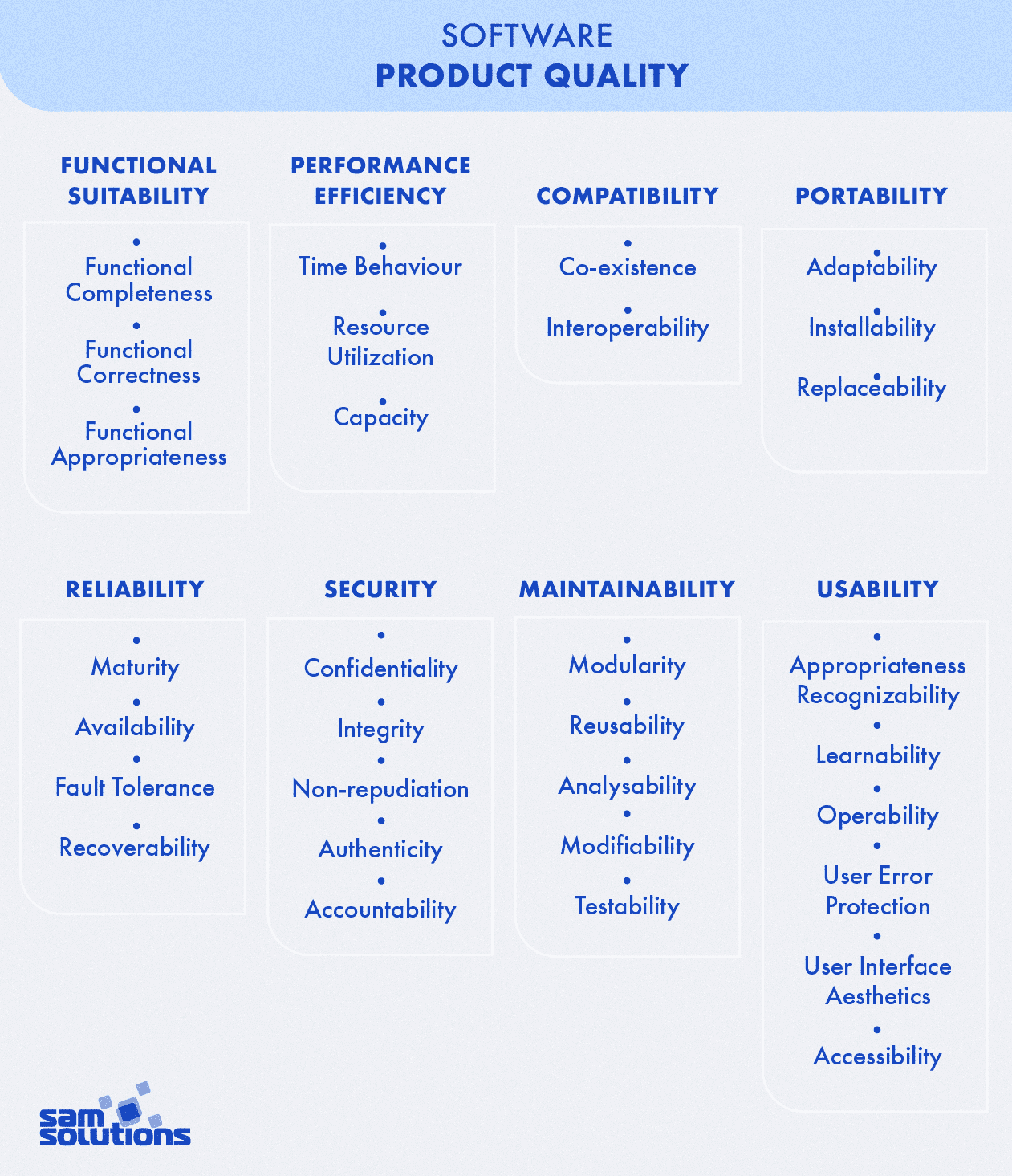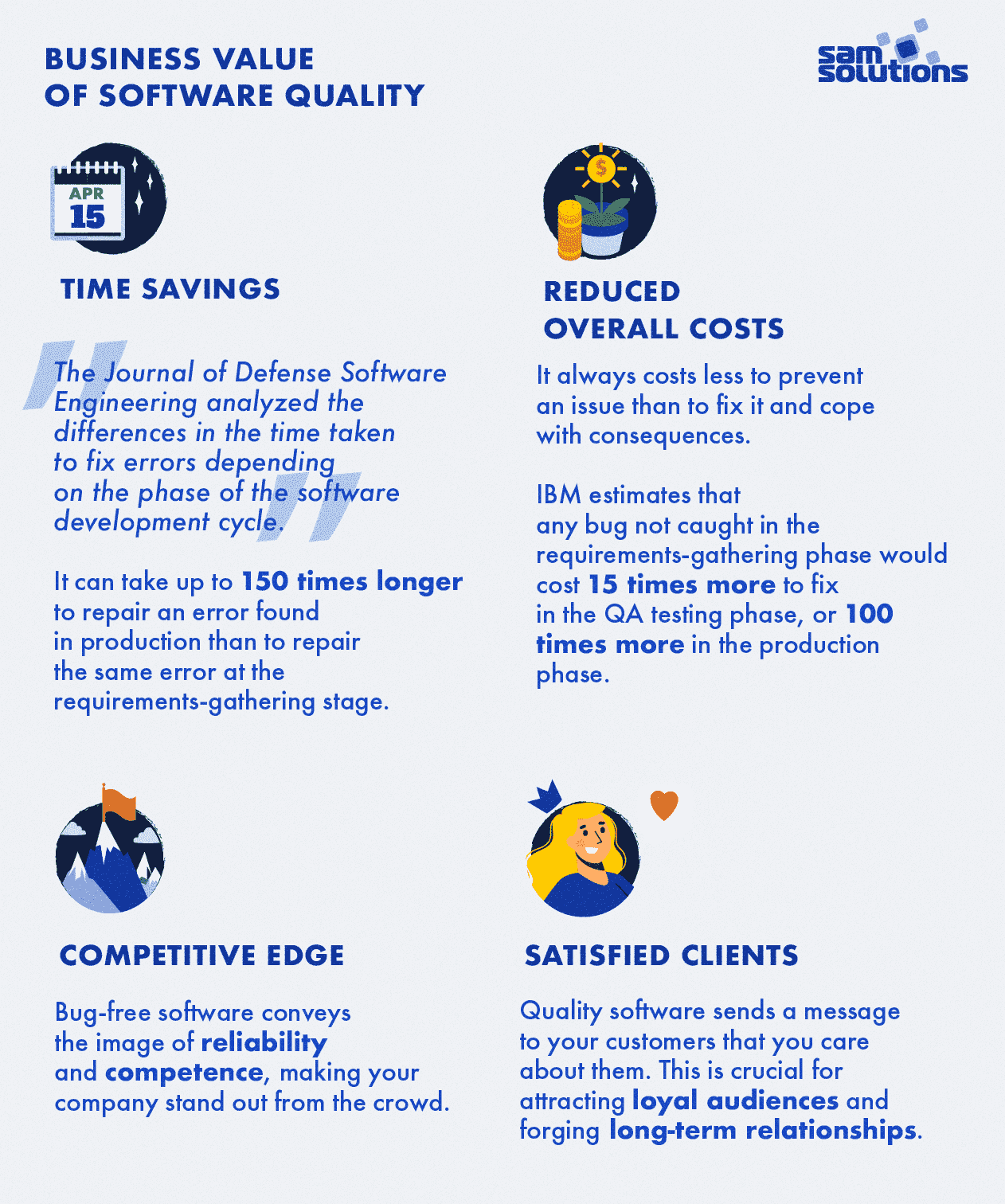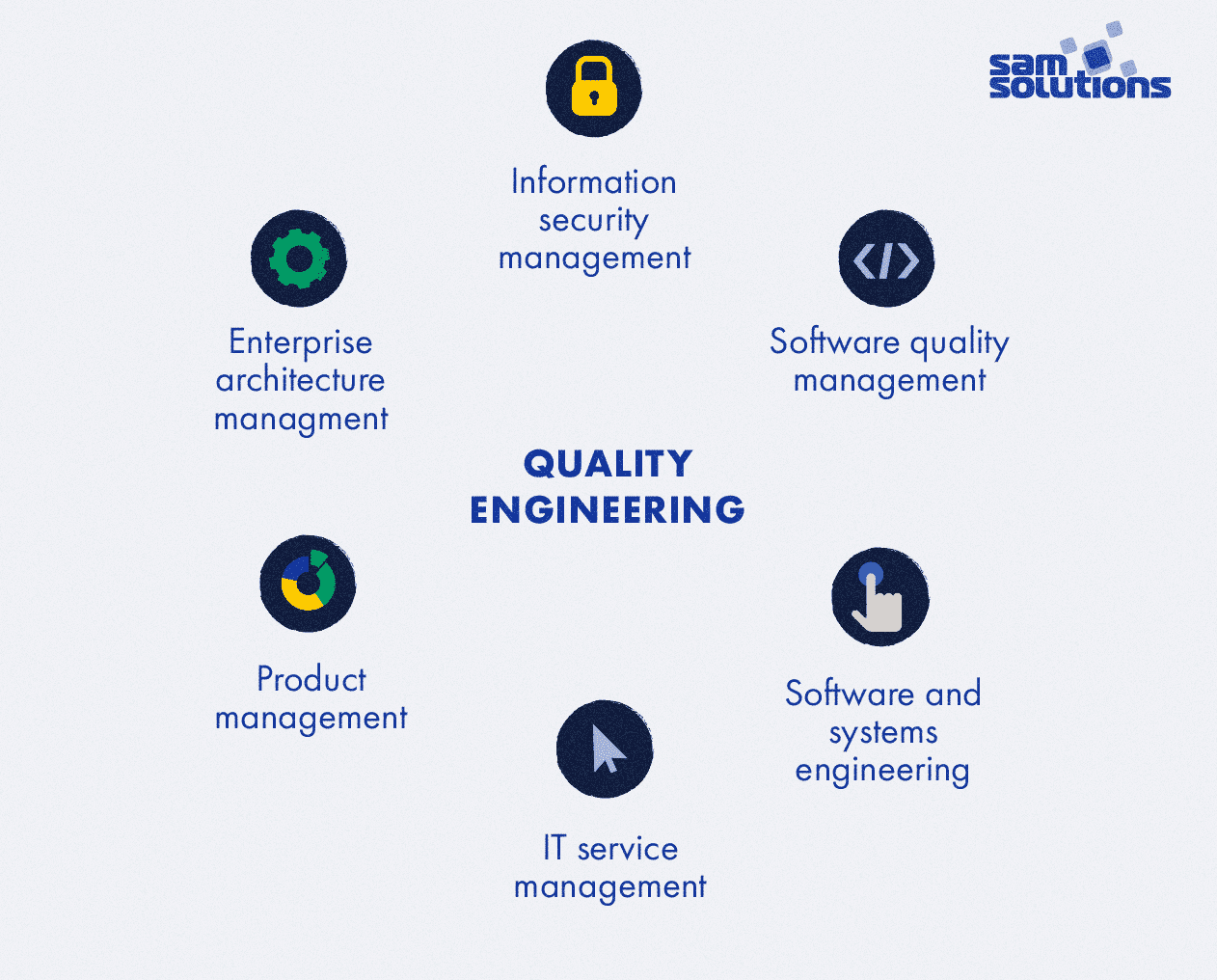IT companies operate in a highly competitive market, constantly striving to attract and retain customers. One of the key criteria for success in the industry is to ensure high quality of software products.
This guide will define software quality and its attributes and talk about best practices in developing reliable digital solutions.
What Is Software Quality?
Software is a product created for end users. As for any other product, the concept of quality implies that software is created in accordance with certain standards and requirements, has no defects and fully satisfies user expectations.
The quality of the software is the degree of its conformity to stated functional and non-functional requirements.
Software Quality Attributes
How can you measure software quality? There are eight attributes defined by the ISO/IEC 25010 standard (the basis of software engineering) you should consider while developing a solution.
- Functional suitability — a solution must correctly perform functions that will satisfy all customer needs.
- Performance efficiency — a solution must have enough capacity and computing power to operate correctly and without delays.
- Compatibility — a solution must provide interoperability, i.e. be compatible with various operating systems, networks or devices.
- Usability — a solution must be easy to use.
- Reliability — a solution must recover from faults without affecting user experience.
- Security — a solution must provide impeccable data protection.
- Maintainability — a solution must be easily maintained and fixed in case of issues.
- Portability — a solution must be able to work in various environments.
Each of these characteristics has additional sub-characteristics, as shown in the table below.

“Product quality is not a monolithic but a compound concept. To evaluate software quality, you should look at it from different angles, taking into account a range of characteristics. A general model for quality evaluation provides an overall vision of quality software. In practice, the importance of an attribute depends on product type, target audience and other factors. That’s why, for each product, we define those aspects on which more emphasis should be placed,” says Siarhei Nestsyarenka, Head of QA at SaM Solutions.
Is Software Quality Important?
Numerous research reports and statistics show that software quality issues are damaging business. Program failures and downtimes result in huge revenue losses, additional expenses and tainted reputation, affecting millions of people.

Conversely, high-grade solutions save money, give companies a competitive edge and attract more loyal customers.

A timely software check for possible bugs and performance issues may prevent businesses from bearing incomparably heavier costs on post-release bug-fixing and reputation recovery.
How to Ensure Software Quality
The majority of tech-first companies prioritize a thorough software quality strategy, making it an integral part of software product development. There are some practices you can put into place: quality assurance (QA), quality control (QC), which is a part of QA, and testing, which is a part of QC.

Quality Assurance (QA)
The QA practice is integrated into the software development process from its initial stage, to monitor that requirements and standards are met during the entire product life cycle.
Quality assurance is a proactive tool that helps prevent issues or fix them at early stages, saving money and time. QA comprises a range of activities such as planning, establishing standards, creating documents, analysis, audits, testing, training of team members, etc.
Quality Control (QC)
There are certain differences between QA and QC. The QC practice is a subset of quality assurance. Unlike QA, a quality control team is involved in the last stages of production, and its task is to detect defects in an almost-ready product, rather than prevent them. That’s why both approaches should be used to ensure quality software.
Thus, QC is a reactive tool that can only identify errors but not find the source of the problem. QC also includes reviews and testing.
Software Testing
Although testing procedures are resource- and time-consuming, they are a must for companies that care about their reputation and customer experience. The numerous types of testing are divided into two groups: functional and non-functional.
Functional Testing
QA engineers use functional testing to check that an application executes its direct functions. The prime advantage of functional testing is that it’s used to simulate how the system really functions. By doing this, testing specialists check that customers can use the software the way it was designed to be used and that all of the features work as intended.
- Unit testing is used to verify small software components or modules.
- Integration testing is used to ensure that integrated components and modules work as intended.
- System testing is used to check the entire system as per requirement specifications.
The QA team may use both manual and automated testing tools depending on project peculiarities.
Non-functional testing
This type of software testing is used to check non-functional aspects such as performance, usability, reliability, etc.
- Performance testing is used to determine the speed, responsiveness and stability under the workload.
- Security testing is used to uncover vulnerabilities of a system to cyber attacks.
- Usability/user experience testing is used to evaluate how easily end users can work with a solution.
- Localization testing is used to verify the quality of software as per specific culture or region.
There are also other types of tests used to control software quality; we’ve merely described the most popular ones.
Quality Engineering (QE) — an Emerging Approach
Besides the traditional QA practice, there is a new emerging approach to software quality named quality engineering. Since this approach is still nascent, it’s plagued by numerous gaps and unanswered questions.
However, the principal idea of QE is that it should foster the culture of quality across the company and that this should be instilled in everybody’s mindset.
In the QE approach, each stage of the product development cycle is under rigorous review by quality engineers. Moreover, quality maintenance is provided long after the product is delivered. The implementation of this strategy in software development processes ensures the sufficiency of the output from the very beginning, minimizes defects and reduces potential losses.
QE is based on end-to-end management and operates with the understanding that quality is the responsibility of everyone involved. This is closely connected to Agile and DevOps methodologies that are currently very popular with many software development companies.
Quality engineering comprises tools and methods from disciplines such as enterprise architecture management, product management, IT service management, software and systems engineering, software quality management and information security management.

Quality engineers play the key role in this methodology, but they don’t work in isolation. To gain a thorough understanding of all the technological activities and evaluation principles, they cooperate with numerous people who have different responsibilities, knowledge and expertise. These include:
- business architects
- IT architects
- designers
- security officers
- requirements engineers
- test managers
- project managers
- product managers.
Thus, QE methodology is even bigger in scale than the traditional QA approach.
Understanding the Cost of Software Quality
Quality assurance is the prerequisite for faultless software operation, and it leads to profit growth and better brand recognition in the long run. QA experts recommend assigning a high priority to software quality best practices, even though it is a cost-intensive process.
Spending a substantial sum of money on QA activities now will let you save much more later, because the real price of software errors is direct financial losses combined with damaged brand reputation and years of lost time.
QA specialists at SaM Solutions have extensive experience and provide a range of services for creating high-grade products. Contact us if you don’t want to deal with software bugs yourself.




















 The Latest 15 Information Technology Trends in 2024
The Latest 15 Information Technology Trends in 2024 Top 10 Embedded Software Development Tools
Top 10 Embedded Software Development Tools IaaS vs. PaaS vs. SaaS: What’s the Difference?
IaaS vs. PaaS vs. SaaS: What’s the Difference? 10 Examples of Predictive Analytics
10 Examples of Predictive Analytics






![Quality Control vs. Quality Assurance [Difference and Comparison]](https://www.sam-solutions.com/blog/wp-content/uploads/2019/06/Quality-assurance-vs-quality-control.png)


